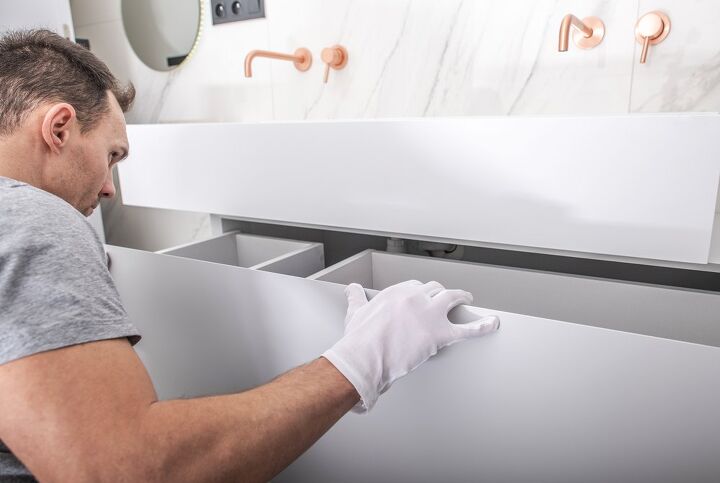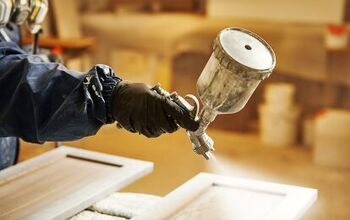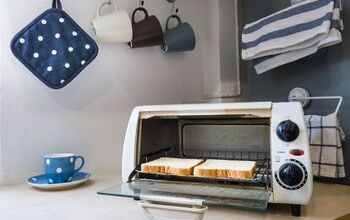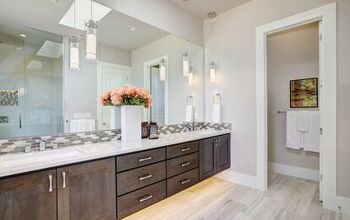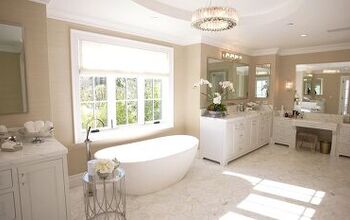Can You Use Kitchen Cabinets In The Bathroom? (Find Out Now!)

Maybe you know exactly how you want your house to look, but can’t find what you need when you go searching for it in stores. For example, I can usually find a variety of cabinet options in the kitchen section, but when I start looking for bathroom cabinets, the selection seems to be much more limited. So, if I find kitchen cabinets that I love, can I put these in the bathroom, or is that a no-go?
Kitchen cabinets are designed differently than bathroom cabinets. They are generally a few inches deeper and taller than bathroom cabinets and often do not come sealed for moisture resistance. Still, you can make kitchen cabinets work in your bathroom with a few modifications. You will need to need to make allowance for your bathroom sink’s plumbing and seal the outside of the cabinets to protect them from moisture.
A little DIY and you can get the bathroom look that you want! We’ll share the essentials for transforming your kitchen cabinets into cabinets that can work in your bathroom.
Do You Need to Hire Cabinet Installers?
Get free, zero-commitment quotes from pro contractors near you.

How are Kitchen Cabinets and Bathroom Cabinets Different?
First, it is important to understand how kitchen cabinets and bathroom cabinets are different to know how to make the proper adjustments.
- Standard kitchen cabinets are usually 24 inches deep, while bathroom cabinets are 21 inches deep.
- Standard kitchen cabinets are 34 inches tall, while bathroom cabinets are generally 31 inches tall.
- A bathroom vanity is designed to cover the base of your sink and its plumbing.
- Bathroom cabinets generally are sealed to be water-resistant.
Counting the Cost
While kitchen cabinets are not usually more or less expensive than bathroom cabinets, you may be looking at sacrificing more hours of your time. If “time is money,” kitchen cabinets may cost you more, but if you enjoy DIY projects, then it may be a good use of your time to get exactly what you want in the end.
Will It Pay Off?
Some factors that may make it worth your time will be:
More storage space
A few cubic square inches won’t take up much of your bathroom floor space, but it does help to store some extra items. Especially in smaller homes or apartments, every extra bit of cabinet space helps when you are trying to hide away personal items or you want to keep a few more towels in a dry space.
A comfortable height
Bathroom sinks historically have been lower to accommodate children as well as adults, while kitchen counters are meant to reach an average adult’s hip. If you have older kids or no kids, you may find a taller counter more comfortable to use.
I, personally, am a fan of having all my countertops closer to hip height. Even with small children, you can make this work with a handy step ladder.
Resale value
The resale value of your house can depend on your home improvements. For example, if you have a shaker-style kitchen, a realtor will want to see the same theme carried out into your bathroom. This doesn’t mean that you necessarily need to have the exact same cabinets in the kitchen as the bathroom. However, it may be easier to find coordinating styles in the same department.
The look you want
If you plan on staying in your home long-term, resale value may not be as important to you as achieving the look you want. Perhaps you found the look you want, but the cabinets are in the kitchen section. Or, maybe you found some vintage kitchen cabinets that you want to install in the bathroom and you want to know how to make it work.
How to Make Your Kitchen Cabinets Work in the Bathroom
To prepare your cabinets for use in the bathroom, you will need to make some adjustments. Here are some things to keep in mind.
Measure First, Cut Last
Before you invest in cabinets, make sure your bathroom has enough space to allow for kitchen cabinets. A few extra inches may not seem like much, but it will be much if your new cabinets block a door or hug your toilet.
Turning a Kitchen Cabinet into a Bathroom Vanity
If you have a kitchen cabinet with a drawer on top and a cabinet underneath, this can be ideal for a bathroom vanity. You should remove the drawer and glue only the face back into place on the cabinet. This makes a nice cover for your sink’s plumbing. Make sure you have space at the back of the cabinet to allow the pipes to exit, as well.
Sealing the Cabinets
Last but not least, you will need to seal your cabinets so they do not become damaged by moisture. You can do this by adding a waterproof finish to the outside of your cabinets, and by caulking the seams.
Waterproofing Wood
You can make wooden cabinets water-resistant in a few simple steps.
Step 1: Sand old finishes off your wood cabinets.You will want to first sand with rougher sandpaper to remove old finishes and imperfections. Then go over it again with fine-grit sandpaper for a smooth surface.
Step 2: Wipe down your cabinets.Remove dust and grit with a damp cloth before applying stain or sealant.
Step 3: Apply your sealant.You can use Tung oil or linseed oil as more natural sealing options. These are long-lasting, but also take a longer time to cure. Or, you can use more traditional sealants such as varnish, lacquer, or polyurethane. These generally have a quicker drying time.
Step 4: Allow your cabinets the proper time to cure.Other cabinet types
Some cabinet types may not need to be treated differently at all as they may already be made out of water-resistant materials. For example, acrylic cabinets are waterproof, laminate cabinets are water-resistant, and MDF cabinets are moisture-resistant.
If you are wanting to waterproof a material besides wood, ask an expert how best to seal your specific cabinet type.
Caulk around seams and fixtures
Don’t forget to caulk around your sink edges and fixtures to protect water from entering your cabinets.
Custom Cabinets
It can be satisfying to create beauty in a DIY project. However, if are not into DIY, or can’t find the right cabinets to fit your space, you can always hire an expert to get the job done. This is usually a more expensive option, but it may be worth it to get the result you want.
Related Questions
Which materials are commonly used for bathroom cabinets?
Solid wood, plywood, MDF, PVC, rubberwood are all popular choices for bathroom cabinets. Many tout MDF as being one of the cheapest options, while PVC and rubberwood are recognized as some of the most water-resistant materials.
Can I use wood cabinets in a bathroom?
Wood is a naturally porous material, which means that it can more easily absorb moisture if it is not properly sealed. Some wood types that have been recommended for bathroom use are Teak, Pine, Koa, Cedar, Cherry, Red oak, White oak, Padauk, and Mahogany.
What is a bathroom vanity vs. a pedestal sink?
A cabinet that is built around your bathroom sink is called a vanity. A vanity is designed to hide your sink’s plumbing and usually also provides counter space on top.A pedestal sink has no cabinet attached. It is simply a sink on a stand (a pedestal).
Do You Need to Hire Cabinet Installers?
Get free, zero-commitment quotes from pro contractors near you.

Summing It Up
Sometimes to get what you want, you have to think outside the box. If you plan to modify a set of kitchen cabinets to install in your bathroom, make sure the larger-sized cabinets fit your space and seal your cabinets to protect them from moisture. It can be worth a little elbow grease to get the result you want!
Related Guides

Alex Praytor is a native Texan who got her degree in English Literature and decided to travel the globe. She finds the architecture and design of homes across cultures fascinating. In her spare time, she visits coffee shops with her family and creates projects for their own home. Alex enjoys sharing tips on how to keep repairs up to date while turning a house into a home.
More by Alex Praytor



